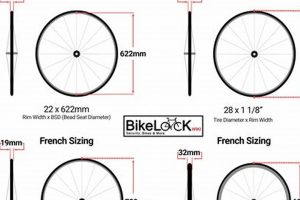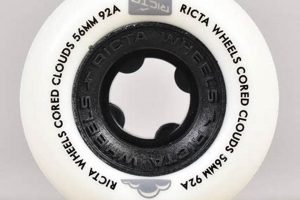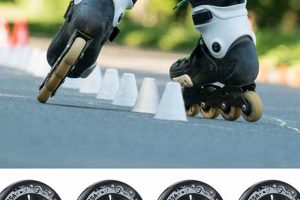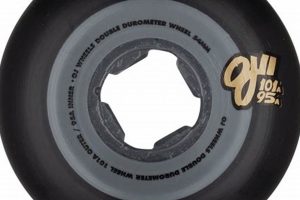The dimensions of circular components affixed to roller skate chassis significantly influence the skating experience. Expressed in millimeters (mm) for diameter and often in durometer (A) for hardness, these measurements dictate speed, maneuverability, and grip. For example, a component measuring 76mm in diameter with a hardness of 82A offers a balance between speed and control suitable for recreational skating.
Appropriate selection impacts performance, safety, and overall enjoyment. Smaller diameter components enhance agility and are often preferred for rink skating and artistic routines. Conversely, larger diameters promote faster speeds and improved roll-over ability, making them suitable for outdoor skating and distance travel. The hardness rating determines grip and wear resistance; softer compounds provide more grip but wear faster, while harder compounds offer increased durability and speed on smooth surfaces. Historically, variations reflected evolving skating styles and surface conditions, driving innovation in materials and design.
Understanding these dimensional characteristics is crucial for informed decision-making when choosing equipment. Subsequent sections will detail specific diameter and durometer considerations, application-specific recommendations, and factors influencing selection.
Essential Considerations for Component Selection
The following guidelines provide critical insight into selecting the most appropriate rolling components for optimal skating performance and longevity.
Tip 1: Diameter Selection Based on Skating Style: Smaller diameters (e.g., 70mm – 76mm) facilitate increased maneuverability and are generally preferred for rink skating and jam skating. Larger diameters (e.g., 80mm – 110mm) enhance speed and roll efficiency, making them more suitable for outdoor recreational skating and speed skating.
Tip 2: Durometer Rating for Surface Compatibility: Softer compounds (e.g., 78A – 82A) offer increased grip and are recommended for rough or uneven surfaces. Harder compounds (e.g., 84A – 90A+) provide greater speed and durability on smooth, indoor surfaces.
Tip 3: Bearing Compatibility: Ensure compatibility with standard 608 bearings, which are commonly used. If using specialized bearings, verify that they are appropriately sized for the chosen hub dimensions.
Tip 4: Hub Material and Design: Components with robust hubs, typically constructed from durable plastics or aluminum, enhance energy transfer and provide a more responsive skating experience. Consider hub design for weight reduction without compromising structural integrity.
Tip 5: Rotation Practices: Periodic rotation, particularly for components subject to uneven wear, extends lifespan and maintains consistent performance characteristics. Follow a regular rotation schedule based on usage frequency and observed wear patterns.
Tip 6: Assess Surface Conditions: Before each skate, evaluate surface conditions to ensure the appropriate component is selected. Rough terrain necessitates softer components for grip, while smooth surfaces benefit from harder components for speed.
Tip 7: Consider Axle Length: Correct axle length ensures secure attachment and prevents binding. Ensure the selected components do not exceed the available axle length on the skate chassis.
These recommendations emphasize the importance of considering several key factors to optimize the skating experience and maximize equipment lifespan.
The succeeding sections will further elaborate on specific applications and address frequently asked questions related to selecting optimal rolling components.
1. Diameter (mm)
The dimension, expressed in millimeters, represents a fundamental parameter influencing roller skate performance. Its selection has direct consequences for speed, maneuverability, and overall skating experience. Variability in diameters caters to diverse skating styles and surface conditions.
- Speed and Acceleration
Larger diameters generally translate to higher top speeds due to increased roll distance per revolution. However, they may exhibit slower initial acceleration. Conversely, smaller diameters provide quicker acceleration but potentially lower top speeds. An example is the use of 110mm wheels for inline speed skating, contrasted with 72mm wheels favored in artistic skating.
- Maneuverability and Agility
Smaller diameters enhance agility and responsiveness, facilitating tighter turns and quicker transitions. This is advantageous for rink skating and roller derby, where rapid changes in direction are crucial. Larger diameters, while less agile, offer improved stability at higher speeds, making them suitable for open road skating.
- Roll-Over Ability and Surface Adaptability
Larger diameters more effectively navigate uneven surfaces and obstacles, providing a smoother ride on rough terrain. Smaller diameters are more susceptible to imperfections on the skating surface, potentially leading to increased vibration and reduced control. Outdoor skating often benefits from larger diameters to overcome cracks and debris.
- Energy Efficiency and Endurance
Larger diameters, once accelerated, tend to maintain momentum more efficiently, reducing the energy required to sustain speed over longer distances. This can be particularly relevant for marathon skating or long-distance recreational skating, contributing to improved endurance and reduced fatigue compared to smaller diameter components.
These diameter-related attributes underscore their significance in determining performance characteristics of skating equipment. Selection must align with skating style, desired speed, surface conditions, and maneuverability requirements, impacting overall user satisfaction and efficiency.
2. Durometer (A)
The “A” scale durometer rating is a crucial parameter defining component hardness and, consequently, its interaction with the skating surface. Its relationship with overall dimensions dictates the balance between grip, speed, and wear resistance. A softer compound, indicated by a lower durometer (e.g., 78A), offers greater grip, conforming to surface irregularities and enhancing control, particularly at lower speeds. This attribute is paramount in situations demanding precise maneuvers and traction on uneven terrain, as seen in roller derby or recreational outdoor skating on asphalt. Conversely, a harder compound, identified by a higher durometer (e.g., 88A), minimizes energy loss due to deformation, resulting in greater speed and roll efficiency. This advantage is crucial for speed skating and smooth indoor surfaces. Selecting the appropriate durometer involves assessing the dominant surface conditions and prioritizing either grip or speed, impacting both performance and safety.
The influence of durometer also extends to wear characteristics. Softer compounds, while offering superior grip, exhibit accelerated wear rates, particularly on abrasive surfaces. This necessitates more frequent component replacement. Harder compounds, conversely, demonstrate greater wear resistance, extending lifespan but potentially sacrificing grip, particularly in wet or oily conditions. Therefore, the selection process necessitates evaluating the trade-off between grip, speed, and longevity, factoring in skating frequency and prevailing environmental factors. For example, a recreational skater using components primarily on smooth indoor surfaces might opt for a higher durometer for increased lifespan, while a competitive roller derby player prioritizes grip and maneuverability with a softer compound, accepting the need for more frequent replacements.
In summary, the durometer rating significantly influences the performance characteristics of skating equipment. Balancing grip, speed, and wear resistance is critical for optimizing the skating experience and ensuring safety. Understanding the impact of durometer, in conjunction with overall dimensions, allows users to tailor their equipment to specific skating styles and environmental conditions, maximizing performance and longevity while mitigating potential risks.
3. Contact Patch
The contact patch, defined as the area where the rolling component makes physical contact with the skating surface, is inextricably linked to overall dimensions. Smaller diameter components, given equivalent loading, exhibit a smaller contact patch than larger diameters. This diminished area translates to higher pressure on the skating surface, potentially increasing friction and affecting roll characteristics. Conversely, larger diameters distribute weight over a broader area, reducing pressure and potentially enhancing roll efficiency. Understanding this relationship is critical for optimizing grip, speed, and stability. The specific material properties of the rolling component, and the skating surface, also influence the size and shape of the contact patch under dynamic conditions.
Variations in contact patch size impact maneuverability and control. A smaller contact patch facilitates quicker turning responses due to reduced resistance to lateral movement. This is advantageous in scenarios requiring rapid changes in direction. However, it may compromise stability at higher speeds. A larger contact patch enhances stability by increasing the area of contact with the skating surface, providing a more secure and predictable feel. This is beneficial for maintaining control during high-speed skating or traversing uneven surfaces. Real-world examples include the selection of smaller-diameter components with smaller contact patches for artistic routines requiring intricate footwork, and larger-diameter components with expanded contact patches for speed skating, where stability is paramount.
Effective management of the contact patch, through informed component selection, is fundamental to achieving optimal performance. Choosing components that align diameter and contact patch dimensions with the intended skating style and surface conditions enables skaters to maximize control, speed, and stability. Addressing this critical connection requires a comprehensive understanding of the interplay between roller skate wheel sizes, durometer, and surface characteristics. Recognizing the practical significance of the contact patch empowers informed decision-making, enhancing both the skating experience and overall safety. Further research is warranted to model the dynamic behavior of contact patches under varying loading conditions and skating speeds, leading to advanced component designs and optimized performance.
4. Hub Material
Hub material, an integral component of roller skate wheel construction, significantly influences the performance characteristics of a given diameter. The material selected for the hub directly impacts structural integrity, load-bearing capacity, and energy transfer during propulsion. A robust hub, typically constructed from materials like high-density polyurethane or aluminum, maintains its shape under stress, ensuring efficient energy transfer from the bearing to the rolling surface. Conversely, a hub constructed from less rigid materials may deform, leading to energy loss and diminished performance, particularly in larger diameter components subject to greater stress. The selection of hub material is, therefore, a critical design consideration that directly correlates with the overall functional attributes of various sizes.
Real-world examples illustrate the practical significance of hub material. Speed skating often employs larger diameters with aluminum hubs to maximize energy return and maintain structural integrity at high velocities. Freestyle skating, on the other hand, frequently uses smaller diameters with more flexible polyurethane hubs, allowing for greater responsiveness during rapid turns and maneuvers. The link between hub material and diameter extends to recreational skating as well; larger diameter wheels for outdoor use often feature reinforced hubs to withstand uneven terrain and prolonged use, while smaller diameter wheels for rink skating may prioritize lightweight hubs for enhanced agility. Discrepancies in hub material, combined with size variations, contribute to the specialized nature of skating equipment.
In conclusion, hub material is not merely a construction detail but a crucial determinant of performance in relation to diameter. The interplay between these two factors governs structural stability, energy transfer, and overall responsiveness. An understanding of this relationship is vital for informed equipment selection, maximizing skating efficiency, and mitigating potential failures. Further research into advanced materials and hub designs promises to enhance performance across all skating disciplines.
5. Bearing Size
Bearing size is a fundamental consideration when evaluating rolling performance across various roller skate wheel diameters. Standardization in bearing dimensions facilitates interchangeability; however, subtle variations impact performance and compatibility.
- Standard Bearing Dimensions (608)
The industry standard 608 bearing, with an 8mm inner diameter, 22mm outer diameter, and 7mm width, is the most prevalent bearing configuration for roller skating applications. This standardization allows for seamless integration with most roller skate wheel sizes, irrespective of diameter, ensuring compatibility across different skating styles.
- Micro Bearing Dimensions (627)
Micro bearings, characterized by smaller dimensions (7mm inner diameter, 19mm outer diameter, and 6mm width), are less common in traditional roller skating but may be encountered in niche applications or specialized setups. Their smaller size necessitates specific wheel hub designs to accommodate the reduced dimensions. Consequently, micro bearings are not universally compatible with all wheel sizes, requiring careful consideration of hub compatibility.
- Impact on Roll Efficiency
Bearing size and quality directly affect roll efficiency. While the outer diameter of the bearing remains consistent in most standard configurations, the internal components and precision of the bearing influence rotational resistance. Higher-quality bearings, irrespective of size, minimize friction and enhance roll speed. The impact on performance is more pronounced in larger wheel sizes, where increased rotational inertia amplifies the benefits of efficient bearings.
- Hub Design Considerations
Wheel hub design is critical to ensure proper bearing seating and alignment. Deviations in hub tolerances can lead to bearing misalignment, increased friction, and premature bearing failure. Correct hub dimensions guarantee optimal bearing performance and longevity, irrespective of wheel diameter. Inspection of hub surfaces and bearing seats should be carried out when replacing bearings to ensure continued operational efficiency.
The compatibility between bearing size and wheel diameter is a cornerstone of roller skate functionality. While the 608 bearing dominates due to its universal adaptability, awareness of alternative bearing configurations and their specific hub requirements is essential for specialized setups. Maintaining proper bearing alignment and selecting high-quality bearings will optimize rolling performance across a spectrum of roller skate wheel sizes.
Frequently Asked Questions
The following section addresses commonly encountered inquiries regarding dimensional aspects and their impact on roller skate performance.
Question 1: Does a larger component invariably result in greater speed?
While larger diameters generally facilitate higher top speeds, acceleration may be slower compared to smaller diameters. The relationship is not linear, and other factors, such as bearing quality and skating surface, contribute significantly.
Question 2: How does durometer selection influence grip and wear?
Lower durometer ratings (e.g., 78A) provide increased grip, particularly on rough surfaces, but typically exhibit accelerated wear rates. Higher durometer ratings (e.g., 85A) prioritize durability and speed on smooth surfaces but may compromise grip.
Question 3: What role does the contact patch play in overall control?
The contact patch, the area of physical contact between the component and the skating surface, influences both grip and stability. A larger contact patch generally enhances stability but may reduce maneuverability. A smaller contact patch facilitates quicker turns but potentially compromises high-speed stability.
Question 4: What hub material is most suitable for demanding skating applications?
Hubs constructed from high-density polyurethane or aluminum offer superior structural integrity and energy transfer, particularly in demanding applications such as speed skating or aggressive skating.
Question 5: Are micro bearings universally compatible with all roller skate components?
Micro bearings (e.g., 627) are not universally compatible. Their smaller dimensions necessitate specific hub designs. Standard 608 bearings are generally the most adaptable, offering seamless integration with the majority of components.
Question 6: How frequently should component rotation be performed?
Rotation frequency depends on usage intensity and observed wear patterns. Regular rotation extends lifespan and maintains consistent performance characteristics, particularly for components subject to uneven wear.
Understanding these dimensional characteristics is crucial for informed decision-making. Proper selection optimizes performance and safety.
The subsequent section offers a conclusion summarizing key considerations related to component selection.
Conclusion
This exploration has systematically detailed the crucial attributes of roller skate wheel sizes, encompassing diameter, durometer, contact patch, hub material, and bearing compatibility. The analysis underscores the interdependence of these dimensional characteristics in dictating performance outcomes. Attentive consideration of each factor is paramount to achieving optimal functionality within specific skating contexts.
The informed selection of roller skate wheel sizes empowers skaters to enhance their performance, improve safety, and maximize equipment lifespan. Continued research and development in materials science and design are anticipated to yield further advancements, optimizing the intricate relationship between components and performance. Skaters are encouraged to apply the insights presented herein to make judicious choices, aligning equipment attributes with intended skating styles and prevailing surface conditions.





![Best Quad Roller Skate Wheels: [Your Choice] & Guide Safem Fabrication - Precision Engineering & Custom Manufacturing Solutions Best Quad Roller Skate Wheels: [Your Choice] & Guide | Safem Fabrication - Precision Engineering & Custom Manufacturing Solutions](https://cruzskateshop.com/wp-content/uploads/2025/06/th-3606-300x200.jpg)

